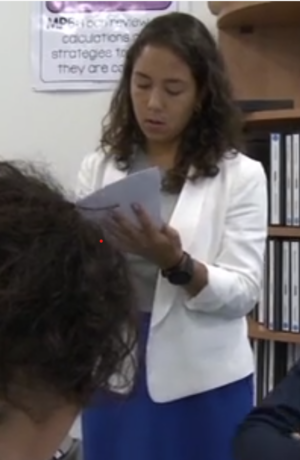01.04.24Managing (Your Own) Working Memory: How Julia Uses Her “Monitoring Key”

Review/Think/Decide
Yesterday I posted about the challenges of managing limits on Working Memory for teachers. We know we’ve got to design our teaching to respond to the challenges the classrooms presents for student’s Working Memory, but we’ve also got to be thinking about the under-acknowledge issue of our own working memory overloads. Walking around the classroom trying to observe and remember what 30 different students understood (and didn’t) on two problems with four steps each while also managing behavior and being responsive to psycho-social needs is a big ask of Working Memory given what we know about its limits. In that setting there is no such thing as taking mental notes. At least not effectively. So yesterday I showed examples of a couple of teachers who had done two really important things:
1) Built themselves and paper-to-pencil tracker to gather data as they circulated. These were more than just a blank space to take notes. In Denarius Frazier’s case he had anticipated and listed likely errors and was ticking off which ones he saw. SUPER efficient. In Erin Magliozzi’s case she was marking up a version of the work students were doing with the names of students to call on at different points.
2) Written out an ‘exemplar’: an ideal answer they hoped students would arrive at. They put this on their clipboard so they could constantly glance at it, thereby, 1) refreshing their own Working Memory (or perhaps better said, allowing themselves to use their WM for toher things knowing they could refresh it at any time) and 2) more easily compare student answers to the ideal and thus spot gaps and errors more quickly.
Today I’d like to follow-up with two more videos on the topic.
- This beautiful video of Julia Addeo ‘Checking for Understanding” in her math class. She’s circulating as students solve a problem and actively seeking to understand more about what they don’t understand. As she does so you can see she’s carrying around her own version of a WM tool–she calls it her “monitoring key.” She glances at it over and over as she responds to student work. This allows her to not have to hold a memory of the solution in her head and thus to be more present and more perceptive with her students. The highlight (for me) comes at thirty seconds or so of the video when you can se her literally step back from the students, review the notes she’s taken and the exemplar she’s build, reflect and then decide on her course of action–there’s a brief and definitive nod when she’s realized what she wants to do. You can watch it here:
2. But we loved this video so much–and though Julia’s teaching was so good–that we interviewed her about it. In this lesson you can hear her talking about what’s on her sheet of paper and why and how she uses it. Again she calls it her “monitoring key” which shows that she’s adapted the idea to her won needs and uses. But a couple of things we noticed: How often she glances at it… that is how helpful it is to be reminded of what she’s looking at and for. She writes on it occasionally. She refers to it constantly even though she clearly knows the math inside out. She just wants to free her WM for other (more important) things. We also notice how often she check her ‘monitoring key’ while she’s deciding. Having her notes in one simple tidy place allows her to think/review/think/review/think/review/decide. Here’s the interview:
Thanks so much to Julia for sharing her insights and teaching with us!
